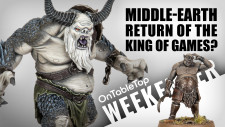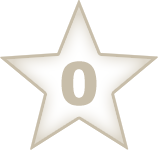Hobgoblin
Review: Streamlined Fantasy Wargaming
October 22, 2023 by umbra
Related Review Types
Supported by (Turn Off)
Supported by (Turn Off)
Introduction
Official name: Mike Hutchinson’s Hobgoblin. Brutal Fantasy Battles.
Mike Hutchinson is the author of Gaslands (a Mad Max like game with small cars) and A Billion Suns (spaceship combat) both published by Osprey Games. When he launched a Kickstarter for a Rank and Flank Fantasy game, I was very curious and jumped on board.
The goal of the game is to maintain the feel of a classic wargame like Warhammer Fantasy and 9th Age, while at the same time create a speedier game. For instance: no half-hour waits while it’s your opponent’s turn. This streamlined game allows you to play faster and/or with bigger armies then would be practical with other game systems.
The game
The rules allow the gamers to play more simultaneous. Eg: player one does his magic phase, than player two does his magic phase; player one does his shooting phase and then player two does his shooting phase. Both players are frequently playing, without long waiting times. This makes it less important who has the first turn as well.
The system to indicate how much damage a unit took, doesn’t so much depict how many losses the unit has suffered. Instead it indicates how stressed the unit is and how willing it is to fight on. You don’t remove miniatures from the unit as they suffer losses. Instead the unit receives doom tokens indicating their increasing stress. Units are removed from the table when they reach ten doom tokens.
A game turn consists of these phases:
- Initiative
One player has the initiative, but the other player can try to steel it. The more turns you have played, the higher the change of successfully stealing the initiative. - Magic
Based on the size of your army and how many wizards you’ve got, you receive mercury tokens. Each wizard chooses a lore with three spells. For a spell you use two, four or six mercury tokens. You don’t need to throw dice during the magic phase. Every spell in which you invest mercury tokens, comes through automatically. And there’s nothing your opponent can do to dispel them. - Shooting
Ranged units shoot by throwing five dice. Once a unit has five doom tokens, it can’t suffer any more damage from enemy shooting.
- Movement
There is no difference between moving and charging in this game. A unit of light infantry can move eight inches. Should the unit while moving bump into an enemy unit, then they are in combat. As usual in rank and flank games, your units wheel when they make a turn. You can reform to let your unit face a different direction, but at the expense of a lot of movement points and you can no longer charge another unit.
- Combat
When attacking another unit, the attacker throws ten dice. The result determines how many doom tokens the defender receives. To determine how many you should throw, there’s a table. Eg: heavy cavalry hits light infantry on a 3+. Light infantry hits heavy cavalry on a 5+.
- Doom phase
During this phase you check which units received enough doom tokens to break. A broken unit gives a doom token to nearby units and is removed from play. By receiving doom tokens from nearby broken units other units can also break. If this process repeats itself, a wave of panic could go through your army and all off a sudden you may have lost half your army.
Because broken units are removed at the end of the turn, these units still move, shoot and fight during the entire turn, before being removed from play.
Army composition
Hobgoblin has no army books for different factions. Each unit belongs to a category (light infantry, heavy infantry, monster,…) and has a point value. By giving keywords (characteristics) to a unit, you can make a unit better or more fitting for a specific army. Eg: fearless, flying, shoot in to combat,… Such a keyword will cost points. Some keywords make your unit weaker and therefor cheaper. Eg: fragile means a unit breaks at 5 doom tokens instead of 10.
Heros and wizards too are keywords you assign to a unit. A hero gives a unit more attacks.
You could combine several armies you possess into one very large army consisting of humans, dwarfs, elves,…
Each army must have a general and a standard bearer allowing nearby units to take more doom tokens before they break. The general is the only character who can carry a magical artifact. In this game they are called cursed artifacts. The give you an advantage, but always bring along a disadvantage.
The official online army builder can be found here: https://hobgoblin.indietabletop.club
What do you need?
Rulebook and cards
The official paper copy of the rulebook will be published early 2024. In the meantime you can obtain an early version of the rules through pre-order (see links below).
The cards are mostly fortune cards. These cards can be played during the game to surprise your opponent (a unit suddenly loses some dome tokens, you suddenly get extra mercury tokens,…). You receive four fortune cards at the start of the game. Then you receive an additional fortune card at the start of every turn and when you take one of your units off the table.
Just like the rulebook: official cards will be published in early 2024. At the moment you can obtain a pdf to print cards through pre-order. This allows you to get by for now. There are other cards as well, with magical spells belonging to different Abyssal Allegiances (= lores), cards with objectives, different ways to deploy your army during the deployment phase,…
Gaming aids
To play Hobgoblin you will need:
- Dice for shooting and close combat.
- Dice or tokens to indicate how many doom tokens a unit has received.
- Dice or tokens to keep track of how many Mercury Tokens you’ve got.
- Something to measure distances in inches.
- A token indicating who has the initiative.
- Something to keep track of which turn you are currently playing.
… and an army.
Off course you will need an army. Even better: a painted army! ?
For the rules it is the size of the movement tray that counts, not how many soldiers the tray contains. You can put as many or as little miniatures on the tray as you which. You could even put miniatures on round bases on movement trays. This allows you to use movement trays and miniatures from Conquest and Song of Ice and Fire for instance. Both games combine rectangular movement trays with round bases.
Infantry and cavalry typically use trays with a width of 10 to 20 cm and a depth of 4 to 16 cm.
The scale of the miniatures doesn’t matter. This allows the use of small scales like 6 mm, 10 mm or 15 mm. Should u use this scale, the author recommends to replace the inches by cm in the rulebook to measure distances in the game.
Conclusion
Not a shooting game
Shooting plays a role, but the emphasis is on close combat. You have to advance forward to defeat your opponent. To try to shoot your opponent of the table, isn’t a viable strategy.
Not a tournament game
This game wasn’t written for tournaments. The margins for the size of the movement trays are an indication of this. A tournament player would always choose the smallest size. The goal of this game is to let you use alle the miniatures you’ve got and perhaps never get to use in other games.
Close combat is brutal!
A battle takes five turns, but after turn three it’s usually clear who won.
Many scenarios
If you like to plays scenario’s: you can generate a new scenario for each battle providing the game with sufficient variation.
Overall
I enjoy playing this game. ?
Links
https://planetsmashergames.com/hobgoblin/
https://www.kickstarter.com/projects/electi-studio/mike-hutchinsons-hobgoblin
https://mike-hutchinsons-hobgoblin.backerkit.com/hosted_preorders
Army Builder: https://hobgoblin.indietabletop.club
Tutorials op YouTube:
- Basic rules: https://youtu.be/kbXiG3z33mI?si=6wKOomKNzFvoU-S-
- Advanced rules: https://youtu.be/UpGsNYAHAqg?si=CpmfN80HMATVacS8
- Building an army: https://youtu.be/0sJ_ZuVYADE?si=dulSunK7jYxN4bp3
- Battle setup: https://youtu.be/kA4tn8EZOo8?si=-i9bfRznOEMHMXwt













































Leave a Reply